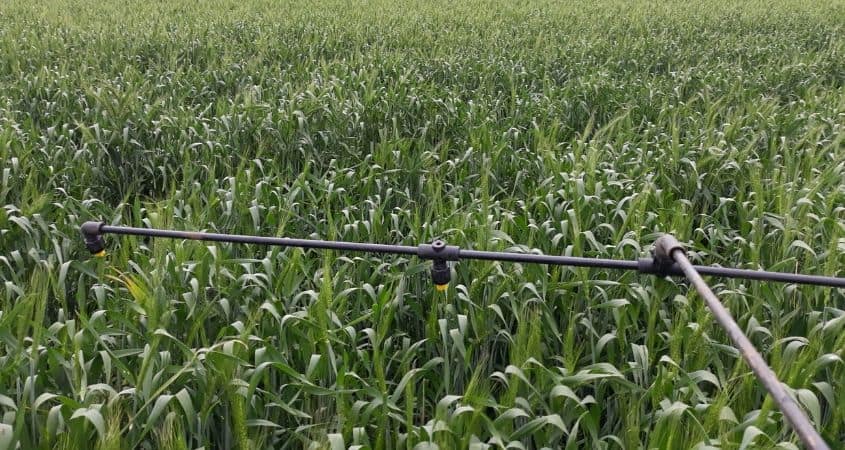
Fungicides are biocidal chemical compounds used to kill parasitic fungi or their spores. Fungi can cause serious damage in agriculture, resulting in critical losses of yield, quality, and profit.
Fungicides are mostly known by their brand names. But when you want to get scientific about farming, it’s important to understand a bit more about which ones to use in different crops, and why they suit particular situations.
This fungicide classification group represent the largest and most significant group, and include active ingredients such as tebuconazole and cyproconazole. These tend not to be the most persistent chemicals in terms of how long they protect the plant, but they do offer both curative and protectant activity on most disease types in many crops.
Triazoles also tend to be a lower disease resistance risk, so are commonly used alone. Many are also off-patent, which means that generic copies have lowered the price of many of these products. Big differences exist in their activity however; prothioconazole is the most recent of the triazoles and is an excellent product in cereals and canola, but offers far less activity on pulse and maize diseases.
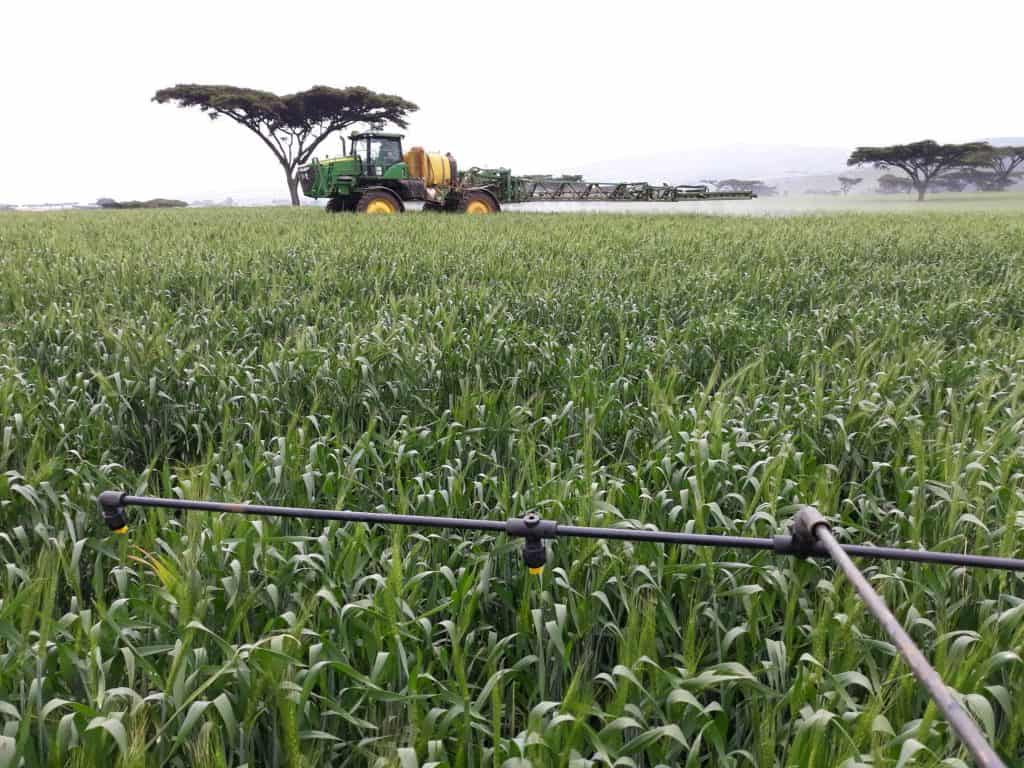
The strobilurin family of chemicals are highly protectant, and when they were discovered in the late 1990’s, made a very dramatic contribution to disease control. Not only in cereals crops, but azoxystrobin, picoxystrobin and pyraclostrobin have been used in maize, fruits and pulses. The particular strength is the duration of control that they provide against initial infection, partly due to their highly systemic activity which allows them to protect new growth.
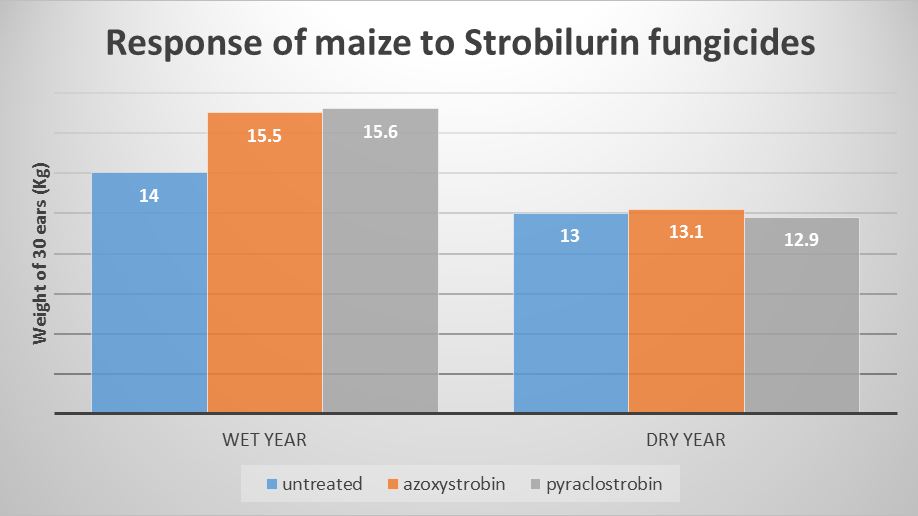
The chart shows a trial in maize that I carried out in both a dry season and a wet season in England; there was no yield response in the dry year, but the previous very wet year saw a yield increase of around 10% from two different fungicides I trialled.
Resistance is widespread in many cereal diseases and developed very rapidly. They are still highly effective against other diseases however, such as Maize Rust, and they do provide physiological benefits to plants (they improve nitrate reductase activity for example, so can increase yield even in the absence of disease).
SDHI fungicides have not arrived in Kenya on field crops yet, but have been a major breakthrough in other parts of the world. Similar in some respects to strobilurins, they offer excellent protection and eradicant activity on several key disease such as Net Blotch in Barley. They tend to be very mobile in the leaf, and show strong systemic activity.
Because they work on just a single site of the fungi, they are at a high risk of resistance developing if they are not used with other active ingredients in a disease control program. Resistance has been identified in the field at low levels already, hence why manufacturers tend to only offer them in mixtures with other chemicals such as triazoles.
I believe the SDHIs could be transformational to barley disease control in particular, provided there activity is safeguarded with anti-resistance measures. Let’s hope that some of these chemicals are approved for use here very soon.
Chlorothalonil remains a vitally important chemical, despite having been around for several decades. Purely a protectant, it has no activity on any infection already in the plant so must be applied before disease appears. It is highly useful in Pulses, and in wheat for protecting against wet weather diseases such as Septoria.
It has no movement in the leaf so only protects what it hits, and it can antagonise some chemicals when tank mixed, so be advised to check with the supplier or agronomist especially when mixing with micronutrients. In purely eradicant situations where you are fighting a well established disease, there is evidence that chlorothalonil can reduce the performance of some triazoles, so its use should be avoided.
Mancozeb is a similar chemical to chlorothalonil, although is more effective on potatoes and horticultural crops, and rarely used on cereals and maize.
Carbendazim is still widely used in many crops, and is a low cost, effective protectant fungicide with activity on stem based diseases in many cereal crops. It is worth noting however that it has been found to be toxic to Earthworms. Sclerotinia populations often show reduced sensitivity to this chemical too.
Once pesticides go ‘off-patent’ they are allowed to be copied and sold by other manufacturers. This competition in the market can be very good news for farmers, but it also bring with it risks.
Although a formulation of a pesticide may contain equivalent amounts of active ingredient (which can be easily tested for in the laboratory), the other co-formulants such as surfactants, solvents, inert carriers and humectants can vary and do not have to be declared on the label.
For this reason caution is needed when choosing products as the efficacy in the field can vary significantly. Cheapest does not always mean good value! The Association of Independent Crop Consultants in the UK tested several formulations of chlorothalonil in the field against Septoria in wheat, and found that cheaper formulations were less persistent and resulted in a lower yield than branded product from the original manufacturer.
What was particularly interesting in this scenario was that farmers and sprayer operators subsequently told us that the results correlated with what they saw in the field; cheaper formulations tend to flow out of the can better, and after several rain showers they appeared to wash off the leaf.
Better formulations with better surfactants and stickers were retained on the leaf even after heavy rain. They also tested EC (emulsifiable concentrate) formulations of the herbicide Pendimethalin compared to the newer Capsule Suspension formulations which promised lower volatility, better weed control and easier spray tank cleaning.
Remarkably the opposite effect was seen on both Ryegrass and Blackgrass; the older EC formulations actually gave better control by around 10% at 1,200grams of active ingredient per hectare.
Tebuconazole has been one of the most widely used fungicides since its introduction in the late 1980’s. Although field performance has dropped off against some diseases such as Septoria, it remains highly effective against many cereal Rusts such as Yellow Rust and Stem Rust, and for eradicating established Maize Rust.
We designed a simple strip trial to compare several generic tebuconazole formulations against Stem Rust in wheat, applied to established disease at full ear emergence.
All were 250g per litre formulations applied at 0.5 l/ha – the lower rate really tests the eradicant activity when the disease is already in the crop, and ensures that they should run out of persistence sooner, amplifying differences between the products.
Spraying in the afternoon sun also brings out any products that are formulated with cheaper solvents and more prone to leaf scorch. In future years we will look to take these through to yield, but this is a rapid and effective way of identifying any particularly poor products to avoid.
The trial is ongoing and the full results will be made available to Agronomy Clients through our network of agronomists, but at present the performance of Orius from Adama has provided the strongest reduction in disease, and interestingly the least expensive product which shall not be named, showed the lowest reduction in disease.
In many parts of the world, Blight populations in potatoes have changed significantly in the past few years, completing their life cycles faster (allowing them to multiply between fungicide applications), survive at lower temperatures and resistant to some fungicides.

All this adds up to more difficult control in the field and the risk of damage both to yields and in store from Tuber Blight infection. Indications from our sampling are firstly that the dominant strains are NOT the aggressive ones that we are seeing in Europe (such as 37_A2). Secondly Metalaxyl is still highly effective, and thirdly Fluazinam is still working.
Metalaxyl is a particularly useful fungicide in the Rapid Canopy Growth stage, where it protects new growth of the plant that is otherwise unprotected by contact or translaminar fungicides just hours after application.
My other choices during Rapid Canopy are dimethomorph containing products or Infinito (although don’t over use Infinito – a great product but keep some back for late on against Tuber Blight too). Zorvec Enicade (oxythiapipolin) has just be released in USA and Europe and will hopefully arrive here soon as early results from independent agronomists in the UK have been impressive.

Fluazinam will need closely monitoring however. It is a fungicide that I have used extensively at the end of the crop to stop zoospores, which fall to the soil and cause Tuber Blight in store. The recent mutation in Europe has rendered this fungicide almost totally ineffective in just 2 years, and there
are few backup options.
In Kenya the only other product with significant tuber blight activity is Infinito (flupicolide + propamocarb), as we do not currently have cyazofamid available.
The latest focus from the Fungicide Resistance Action Committee (FRAC) is to avoid using single mode of action chemicals. Revus (mandipropamid) for example I always mix with mancozeb which is cheap and effective.
Also don’t forget cymoxanil. Often available in mixtures with mancozeb, this has slight curative activity on new Blight infections and is very cheap. And lastly, don’t get too carried away with products – timing and keeping the spray interval to 10 days max is the most important factor of all.
Net blotch disease is one of the main yield robber in barley here in Kenya. But with the range of fungicide products on the market, where do you start to ensure that you maximize the return on your fungicide spend and achieve top yields?
Firstly, let’s go back a step. Good disease control starts with:
Assuming you have carried out the above, what is disease then costing you? Back in 2017, I set up the first barley fungicide trial at Timau. This was a fully replicated, 8 treatment trial which looked at a range of products and timings. Despite reasonable rainfall (the field averaged over 7 tons/ha), there was no visual difference in disease in the crop.
So much so that my test yields from small areas of the replicated plots actually showed no statistical difference in yield between the untreated control and a very robust four spray fungicide program, so the rest of the trial was not actually harvested.
This is, one assumes, a rare occurrence. But as an independent agronomist my job is to lay out ALL of the facts, not to present a particular picture, and this is indeed one outcome. In most severe Net Blotch scenarios a yield response to fungicides of 20-30% is more typical. For a 5 ton/ha crop this is around 37,000 Ksh (370 USD). In other words, it justifies the cost of a robust fungicide program.
Below is the result at the other end of the spectrum. Our barley variety trial in the same location this season has one whole replicate untreated, and the other three have received a full fungicide program:

The reason for this is partly to look at fungicide response, but mainly to examine individual candidate varieties’ disease resistance. The above picture shows what happens when the standard variety Cocktail is left untreated.
The candidate I001 is particularly impressive and the untreated still has some green leaf. Not perfect, but a lot cleaner than the Cocktail. The point of this exercise is to look at what happens if you get your spray timings wrong, or if disease pressure is extreme.
Now, let’s take a look at one of our fungicide trials. This one is in a crop of Cocktail north of Nakuru. Although the crop is only at the flag leaf fully emerged stage, the infection in the untreated is very visible on leaf 3 already.

The standard program of 1.0 l/ha Skyway followed by 0.75 l/ha Skyway has been extremely effective. In my opinion this is the only fungicide worth considering on barley at present. Prothioconazole is very strong on Net Blotch and the Bixafen SDHI is a step forward over Prosaro.
The real revelation is the addition of an inexpensive T0 spray at mid to late tillering. It is hard to capture in a photo but infection on leaves 4 and 5 is far lower than the two spray program.

I have also been looking at the addition of a strobilurin such as azoxystrobin, but have seen no yield response. This should not be a surprise as although it is a very useful product, it demonstrates very little activity on Net Blotch. The same is true for trifloxystrobin and picoxystrobin.
I always advocate keeping spray intervals to 3 weeks, or 4 at the absolute most. For this reason I am also looking at the addition of a final spray at early flowering. In order to use some different chemistry I am looking at Abacus to avoid over using Skyway in the program.
Pyraclostrobin is not the strongest on Net Blotch – like the rest of the strobilurins – but combined with epoxiconazole it is the next best option after Skyway in my opinion. My feeling at the moment is that this final spray is unlikely to be necessary.
On the link below is some Independent fungicide trials data is published by the AHDB in the UK. They are a levy funded research body paid for by farmers and have no commercial or sales interest. Some of the chemicals are not available here, but it gives you a good indication of what is effective.
Unlike wheat, barley responds much more strongly to what we call the T1 timing spray at GS30. The number of spikelets (and hence grains) is determined at this timing. That is why I use a full rate Skyway at T1 then a slightly lower rate at T2 (flag leaf timing).

In many countries an SDHI seed dressing is proving to be highly effective against Net Blotch, reducing inoculum on the seed and protecting the young plant from day 1. Systiva in Australia and Raxil Star in Europe have performed very well.
Below is a trial that I set up with an SDHI seed dressing on the right and a standard fungicide program all the way through. If and when they do become available it will be a big step forward particularly as clean seed is virtually non-existent in Kenya. However, overusing SDHI’s either as foliar sprays or seed treatments will shorten their life significantly. In Europe if you use Raxil Star you can only use an SDHI such as Skyway once on the crop.
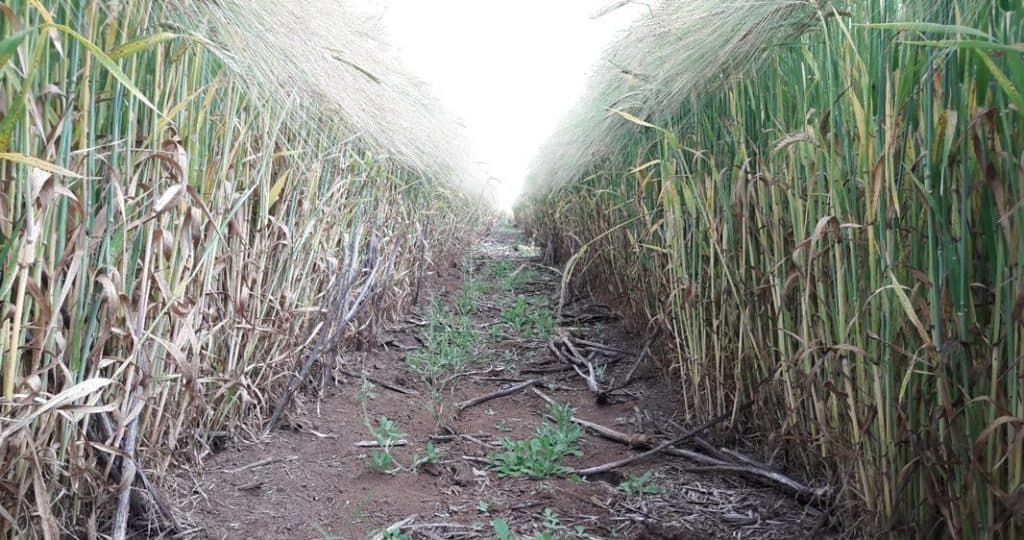
For most wheat diseases – Septoria, Yellow Rust, Tan Spot etc – it is very rare to see responses to fungicides beyond the traditional flowering or ‘ear wash’ spray timing. This changes drastically with Stem Rust however because of the speed at which UG99 in particular gets into crops during grainfill. The picture below from our trials in Naivasha show very clearly the effects of late Stem Rust infection.
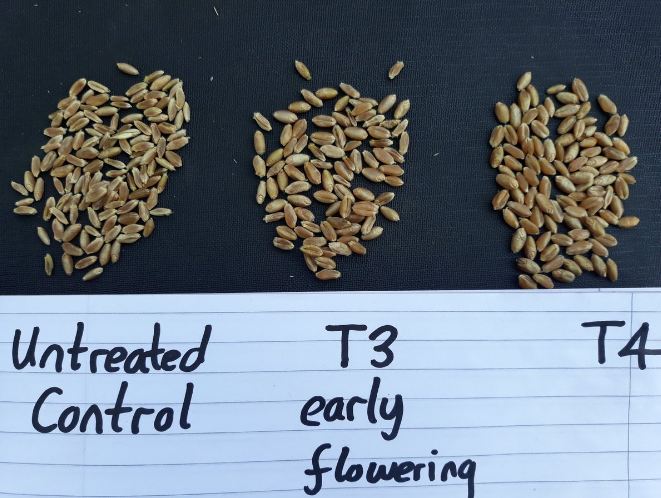
The untreated control which has received no fungicides whatsoever is visually shrivelled. Where THREE fungicides were applied, the last at early flowering targeting Fusarium, there are far fewer shrivelled grains in the sample.
Where FOUR fungicides were applied (we looked at Silvacur, Evito T, Abacus, Amistar + tebuconazole and a new SDHI/triazole/strobe at this timing), all of the treatments had massively improved grain quality.
The full results will be discussed with agronomy members, but the major conclusions are; an early stem extension fungicide appears to be of little benefit (not the first time we have seen this), and keep up the pressure late with robust ear wash (T3) and follow up (T4) sprays on all but the most resistant varieties (Eldo Baraka for example).
Cropnuts Wheat Variety Stem Rust ratings*
| Very susceptible | Robin |
| Susceptible | Hawk, Korongo |
| Reasonable resistance | Kwale, Wren, Tai |
| Very resistant | Eldo Baraka, Eldo Mavuno, Brambling |
*Based on Cropnuts variety trials and our agronomists’ field observations.
Up to 7% increase in yield and significant quality improvements have been seen in our maize fungicide trial in Nakuru this season.

Carried out in a commercial crop of Pannar 691, even the untreated plot yield yielded 9.9 t/ha or 44 bags per acre as disease pressure was very low, with no Rust and only small amounts of Northern Corn Leaf Blight late in the season.
The three major lessons for maize growers are very similar to other parts of the world and are:
Several fungicide were compared at Tassling with strobilurins showing a consistent response, whereas straight triazoles such as tebuconazole did not.
Timing of fungicide application was also compared using azoystrobin as a standard treatment; at 10 leaf stage, Tassling and Grainfill and combinations of the two applications. Later timings were far more consistent and the highest yield response of 7% (690kg or 3 bags/acre) gave an extra return 10,600 ksh per hectare after the fungicide cost). This is before the increased value and marketability of the grain is taken into account.
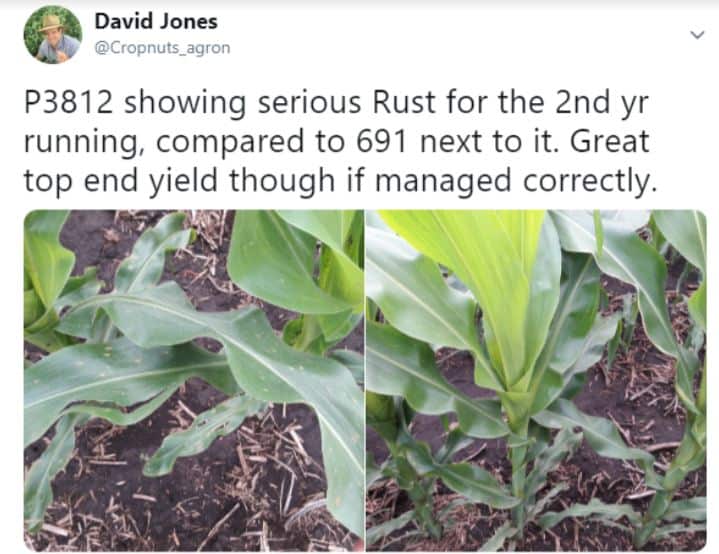
The table below gives an indication of a few common varieties from our trials sites across the country. Remember, just because a variety has a poor disease rating does not make it a bad variety. P3812W has a very high yield potential provided the Rust risk is managed, as can Grey Leaf Spot be protected against in H614.
| Low Disease Pressure | Moderate Risk | High Risk |
| PAN 691 | DK 9089 | P3812W |
| SY 594 | 4m-19 | DK 8031 |
| 30G19 | SC Twiga 83 | H614 |
| DK 777 | H6213 | SC 403 |
Our 2019 pea fungicide trials has highlighted the effectiveness of elemental sulphur for controlling Powdery Mildew. Alternatives with known activity on the disease were tested including metrafenone, triadimefon and azoxystrobin + cyproconazole but while useful, but none were quite
as effective as elemental sulphur.
All of these products are preventative so must be applied before the disease is becoming established. 2kg/ha of elemental sulphur provides around 3 weeks protection, so if applied at flat pod stage the application will likely need to be repeated to ensure a clean crop at harvest.


Farming for the future requires a change of approach. Monoculture, soil degradation and climate change and soil degradation are threats to the future of how we feed the planet. Agventure Ltd set up the Center of Excellence for Crop Rotation to help farmers diversify cropping systems and introduce techniques which have a long-term outlook to improve soil health. The Center of Excellence for Crop Rotation works extensively with Crop Nutrition Laboratory Services Ltd (Cropnuts).

David Jones is the Broad Acre Specialist at Crop Nutrition Laboratory Services Ltd. (CROPNUTS). David has a keen interest in soils and no till farming systems where he has undertaken work looking into weed levels and changes in soil structure, and has extensive experience in field trials and in the development of precision farming techniques. In his spare time he enjoys playing rugby.
Order our services and get to know how to improve your soil for better yeilds.